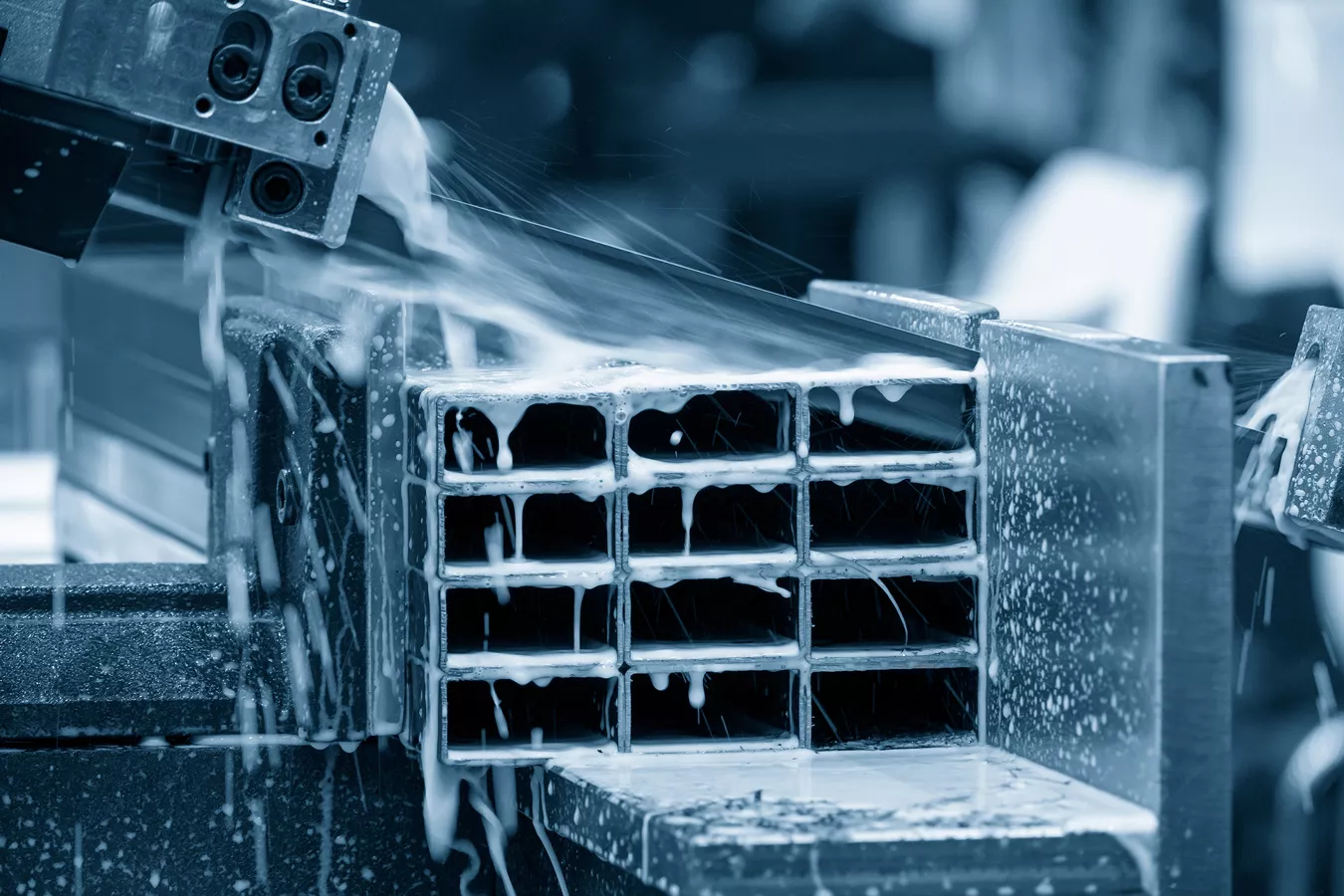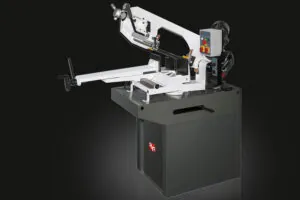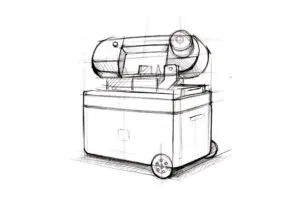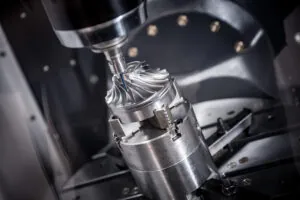How to keep your metal band saw running smoothly and reliably
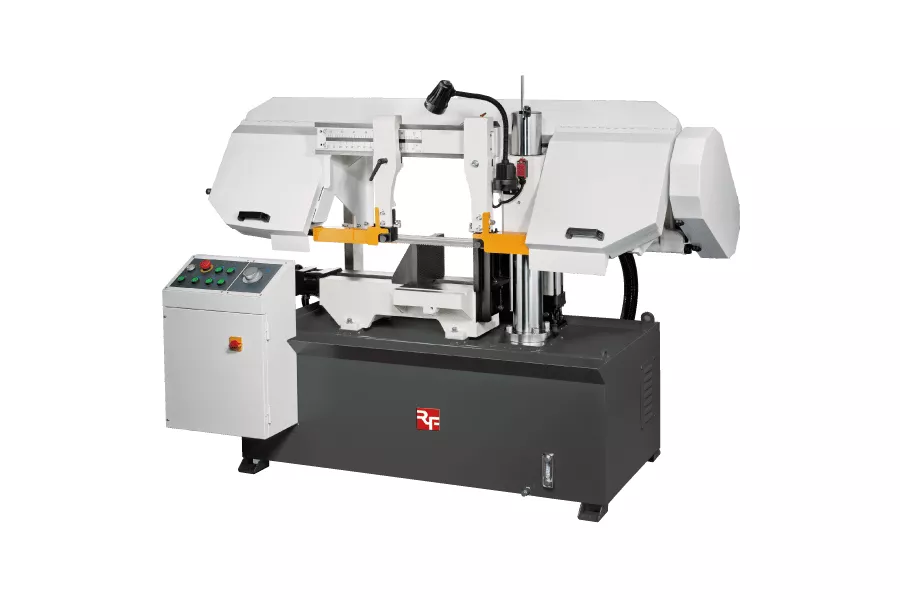
Table of Contents
Why is my band saw not working properly?
- Don’t worry, most problems have simple solutions!
- Step by step troubleshooting is easy to do
A metal cutting band saw looks complicated, and may have a lot of features and accessories, like the semi-automatic Rong Fu RF-300 in the picture above. Fortunately, band saws have worked the same way for two hundred years, so if you understand the basics you can use that knowledge to help you troubleshoot any band saw.
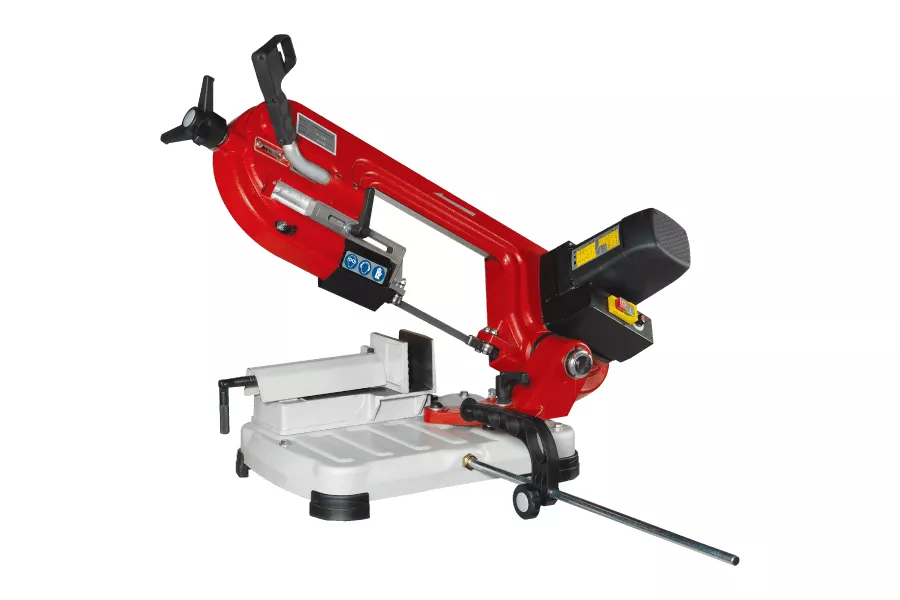
The RF-300 shares common features with even the smallest and simplest of band saws, like the portable Rong Fu RF-150V (above). This makes it quite easy to troubleshoot and solve most problems yourself with a bit of patience and some step by step guidance.
Refer to our metal cutting band saw tuning guide for details of how to do the adjustments required. If you’ve managed to break a blade, then we also have detailed instructions on best practice in installing and adjusting your metal cutting bandsaw blade.
First Things First: Basic Checks For Your Metal Cutting Bandsaw
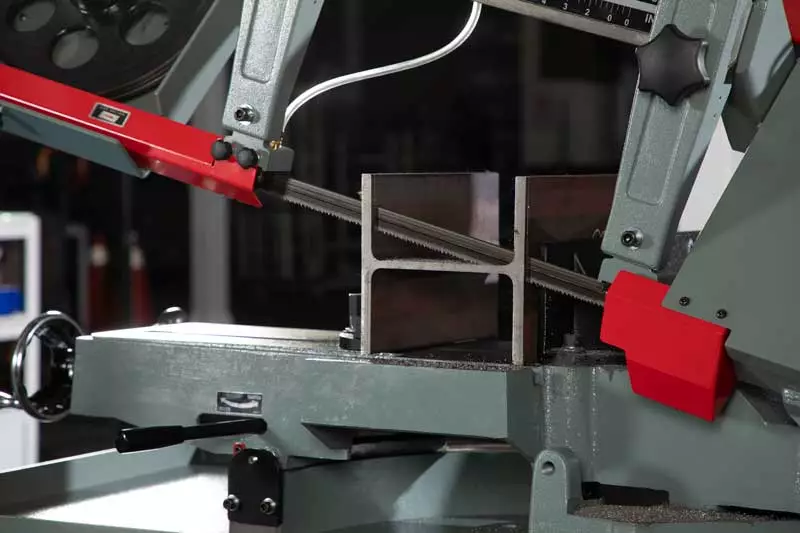
There are three things you should check before anything else, as they are common causes of several different problems:
- Is it the correct type of blade?
- Is the blade heavily worn?
- Are you using the correct feed speed and pressure?
A blade with the wrong pitch or of the wrong type for the metal you are cutting will never cut well. A heavily worn blade will also seriously affect the quality of your cut. Trying to cut too fast or applying too much pressure will cause increased wear on teeth and the back of the blade as well as bending the blade in the cut.
What are common band saw problems you can fix yourself?
It shouldn’t be a surprise that the common problems people talk about are all related to how well your metal cutting band saw cuts. After all, you have a metal cutting band saw so you can make rapid, clean, straight cuts in metal!
If your metal cutting band saw is still giving you any of the following problems after you’ve checked the basics, then don’t worry, it’s still likely you can fix it with some simple adjustments.
The 6 Common Band Saw Problems
- Inaccurate cutting, or ‘drift’
- Rough cutting
- Blade gets dull quickly
- Broken or stripped teeth
- Back of blade wears rapidly
- Blade breaks
Problem 1: Inaccurate Cutting, Or ‘Drift’
If your blade is drifting about and you can’t get a straight cut, there are three things to check to get a better cut.
1. Blade Guide Alignment
If the guide arms are loose or too far apart the blade has space to wobble before it hits the stock you are cutting. Remember that the guides are there to keep the blade aligned and vertical while it cuts.
Bring the blade guides closer to the start and finish of the cut and see if that makes the cut straighter. Make sure the guides are in contact with the blade and properly tightened up but not gripping the blade tightly. You might want to take a look at our guide to tuning your band saw for best performance.
2. Feed Speed, Blade Wear & Blade Type
Inaccurate cutting is also caused by the wrong feed speed (too fast or slow), blade wear and using a blade with the wrong tooth pitch or type for the stock you are cutting, so you may identify these issues in the basic checks you’ve already carried out.
3. Clamping & Lubrication
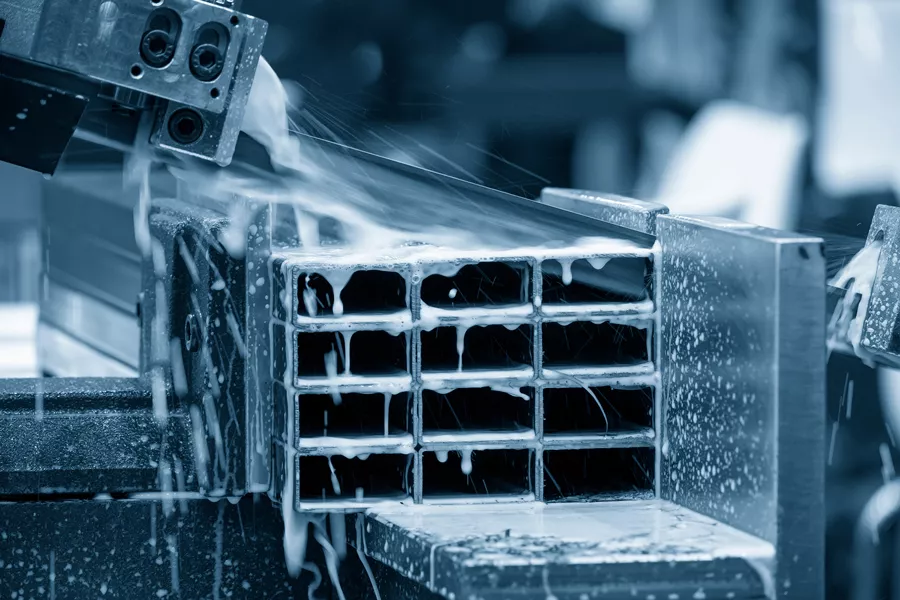
It pays to check that the stock is securely clamped and fastened in the vice and has not become loose through vibration, and you have appropriate support for longer pieces. This is also basic health & safety with your metal cutting bandsaw! Poor lubrication can also make a blade less stable in the cut, so check you are using enough cutting fluid.
Problem 2: Rough Cutting
Rough cutting can be fixed by basic checks and adjustments, so check feed speed, blade type and wear, because a dull blade will always cut roughly. There are two other causes you also need to check.
1. Blade Guide Alignment
Like inaccurate cutting, rough cutting can be caused by not having the guide arms close enough to the stock or correctly aligned to support the blade and twist the blade into a vertical position, so check this first and make any adjustments necessary.
2. Blade Tension
A loose blade will cut roughly, so check the blade tension and adjust it to ensure it meets the specifications in your user manual. Refer to our tuning guide and blade installation and adjustment guide for the general procedures required.
Problem 3: Blade Gets Dull Quickly
There are five main reasons why a blade might wear out faster than you expect, even when aligned correctly.
1. The Blade Is Cutting Backwards
Sometimes we all do it, and put a blade in the wrong way round. It’s one of the last things that someone usually thinks of when their blade is getting rapidly worn, but also very easy to check, so have a look to make sure the teeth are pointing in the right direction!
2. Blade Not Broken In Properly
If you haven’t broken in the blade properly it will wear much faster than it should. So check to see if the blade has been fitted recently and refer to our guide to breaking in a new metal cutting band saw blade if you think it might be the cause.
3. Cutting Hard Materials
Hard materials and materials with heavy scaling will increase blade wear, so it may be that the blade is getting dull at the rate you should expect. Check the blade and material specifications to ensure you have the right blade and are using the correct feed pressure and speed to maximize the life of the blade.
4. Wrong Blade Speed & Feed Pressure
This is a basic check, but has specific issues with blade wear. If the feed pressure is too low you can end up work hardening the metal you are cutting, making it more resistant to being cut. This is a particular problem with stainless steels, which may require a higher feed pressure.
Having too high a feed pressure can also cause blade wear, especially if the blade speed is too fast, so you may need to try varying speed and pressure up and down and monitoring the results carefully to find the best combination of speed and pressure.
5. Wrong Cutting Fluid Settings
Your blade needs enough cutting fluid, and the right kind of cutting fluid, to keep it cool and reduce friction. Check that you have enough flow, the cutting fluid is clean, and that it matches the recommendations for the material and speed you are cutting at.
Problem 4: Broken Or Stripped Teeth
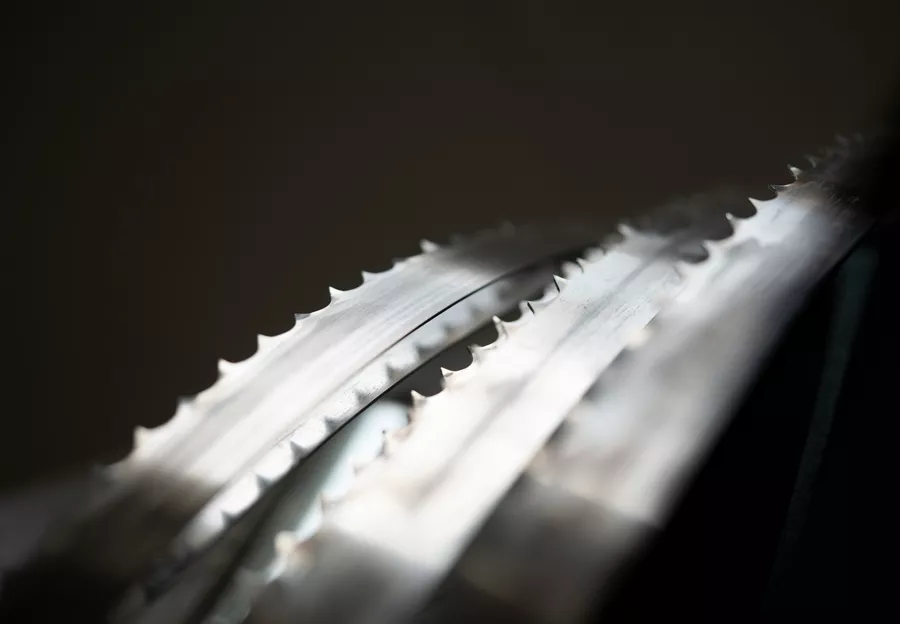
You really don’t want to break or strip teeth off your blade, as this will make even a new blade useless for fine cutting. Basic checks should reduce problems caused by using a blade with the wrong tooth pitch or setting the wrong feed speed and pressure. There are four other likely causes you need to look at as well.
1. Guide Alignment
Bending and twisting of the blade increases the stress around the teeth and can cause them to break. Poor guide alignment usually causes fractures at the back of the tooth where the twisting stress is greatest.
2. Loose Clamping
If the stock can shift or roll in the vice, or is vibrating because it is long and not supported properly, this can jam teeth in the cut, causing them to break. Always check that your stock is clamped firmly and appropriately, as outlined in our health & safety guide.
3. Tooth Broken In Cut
If a tooth has broken off in the cut it will rapidly strip more teeth off your bandsaw blade. Stop cutting immediately and don’t put a new blade back in the same cut or it will lose its teeth as well!
4. Wrong Cutting Fluid
Insufficient fluid flow or the wrong type of fluid will cause the blade to overheat and stick in the cut, increasing the likelihood of teeth stripping off the blade. Check your feed to fluid ratio to make sure it matches the guidance in your metal band saw manual for the material you are cutting.
Problem 5: Back Of Blade Wears Rapidly
If you are using the right type of blade, with the correct tooth pitch for the job and at the right speed and feed pressure but the back of the blade is still wearing quickly then there are three likely causes for this.
1. Pressure Block Wear & Adjustment
The pressure blocks that are preloaded on the back of the blade may either be worn or may need adjustment to keep the blade vertically aligned without excessive pressure. Refer to your manual for the optimum settings required.
2. Guide Arms Too Far Apart
The guide arms need to give the blade enough support to stop it from bending upwards when under pressure, so check the guide arms are close to the cut, with enough of a gap to allow the blade to twist into a vertical position as it enters the cut.
3. Blade Running Hard Against Guide Wheel Flanges
As we’ve covered in our guide to installing and adjusting a new blade, the tracking needs to be correctly adjusted to keep the blade on the guide wheels but not pressed hard against the flanges. A blade that is noisy when it’s not cutting is an indicator that the tracking is not properly adjusted.
Problem 6: Blade Breaks
If you’re using the right type of blade with the correct feed settings and it breaks unexpectedly then you may need to check seven things to find out why it is breaking. It’s worth checking everything carefully before fitting a new blade to make sure it doesn’t happen again!
1. Wrong Cutting Fluid
Incorrect cutting fluid and insufficient cutting fluid will cause overheating and jamming of the blade in the cut, this can rapidly cause a blade to fail, so ensure your fluid settings and type are both correct for the job you are doing.
2. Blade Tension Too High
Blades only need enough tension to keep them tight on the wheel, and because they need to be made of hard materials to cut cleanly they are surprisingly fragile. If you over tension the blade it will cause pressure fractures that lead to blade breakages.
3. Worn Pressure Block
If the pressure block is worn badly, or chipped, this can grab the back of the blade and make it break, so this is a very sensible thing to check and replace if necessary.
4. Blade Rubbing On Wheel Flange
Make sure you have correctly tuned your blade before use. A combination of the blade rubbing on the wheel flange and over-tensioning the blade will break most blades very quickly.
5. Blade Wrong Size For Wheel
Wide blades need large diameter wheels to even out stresses on the blade. Small diameter wheels should be fitted with narrower blades. Check the manufacturer’s guidance to make sure you are using the right width of blade for your wheel size.
6. Saw Started With Teeth In Contact With Cut
You should never start the saw with the teeth in the cut or resting on the edge of the material you are about to cut. This is a very common cause of blade failure because of the sudden high stress that it causes on the point of contact. Make sure your blade is clear before starting it.
7. Blade Side Guide Too Tight
If you are deflecting the blade too far with the side guide then this will cause high localized stress on the blade as it runs through. This can easily lead to a blade developing stress fractures and breaking.
Further Information
This article has given an overview of troubleshooting your metal cutting band saw, and to help you work through the steps required. Metal cutting band saws share many common features, but specific details do vary between machines. For any adjustments we recommend you read your metal cutting band saw manual carefully before you start to check the exact steps required.
You can also contact our technical team for more information or assistance.


